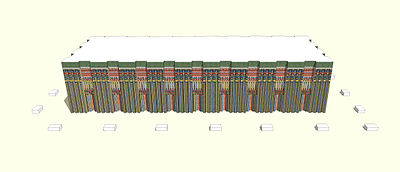Mastaba S3503

Mastaba S3503(Saqqara Tomb No. 3503) is a largemastabatomb at theSaqqara necropolisinLower Egypt.The burial was constructed around 3000 BC during theFirst Dynastyof Ancient Egypt.
Structure
[edit]The structure was excavated byWalter Bryan Emeryand his team atSaqqara.The superstructure of the mastaba is 42 metres long and 16 metres wide and was made from sun-driedmudbricks.The exterior was decorated with a palacefacade,with ninenicheson the long sides and three on each of the short sides. Within the structure were 23 chambers. Below the ground level was a large burial chamber in the middle of the building with four side chambers. There are 20 subsidiary tombs arranged around the structure.
Contents
[edit]The tomb was probably robbed in ancient times. The burial chamber was also robbed, but still contained many items in their original locations when it was excavated, which allowed a relatively good idea of the original contents.
In the centre of the tomb chamber was a largesarcophagus,of which only a few wooden planks were found. It measured about 2.7 x 1.8 metres. The remains of a skeleton were also found, but it could not be determined whether they belonged to a man or a woman. On the east side of the sarcophagus were bowls and vessels, which formed a meal for the deceased. On the walls of the burial chamber were many stone and pottery vessels, but also the remains of a chest. North of the sarcophagus were poles which were probably intended for a canopy or a tent.
Occupant
[edit]The sole occupant's identity is unknown. Emery suggested it was QueenMeritneith,since her name appeared on some objects andcylinder sealingswith her name and that of KingDjerwere found in the tomb.[1]This suggestion has since been abandoned, since Meritneith's tomb has been found atAbydos.The occupant of S3503 therefore remains anonymous. Others have suggested an individual named Seshemka.[2]
Bibliography
[edit]- Walter B. Emery:The Great Tombs of the First Dynasty.Vol 2. Egypt Exploration Society, London 1954, pp. 128–170.
References
[edit]- ^Emery:The Great Tombs of the First Dynasty.Vol. 2, p. 169, Fig. 226
- ^Not sparing the child: human sacrifice in the ancient world and beyond: studies in honor of Professor Paul G. Mosca.London: Bloomsbury Academic. 26 February 2015. p. 38.ISBN9780567352637.

